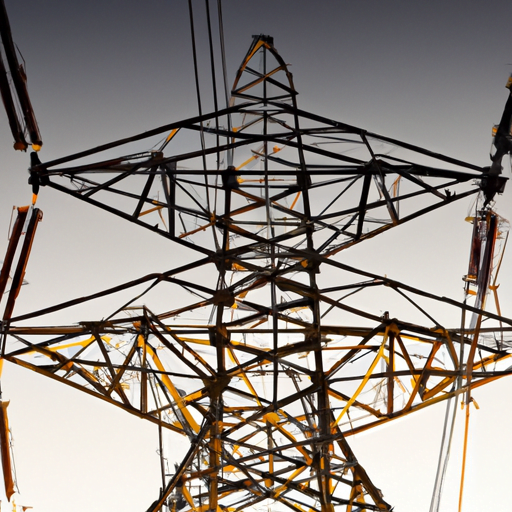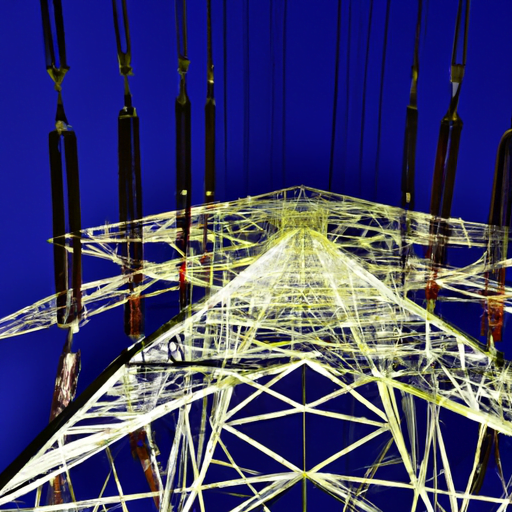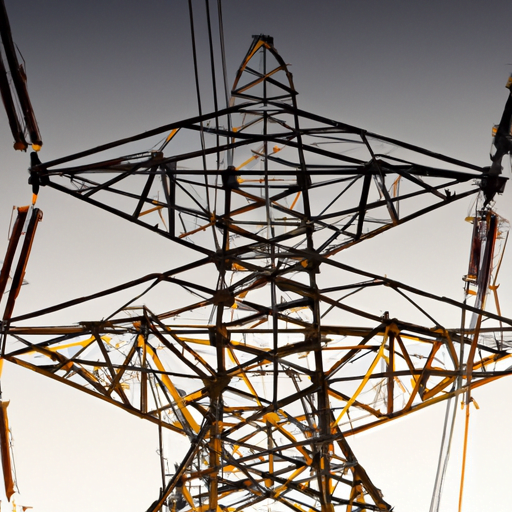Have you ever wondered how efficient the power grid system is? I mean, we use electricity every single day, but do we actually know how it gets to us and how much energy is wasted along the way? It’s something worth thinking about, don’t you think? Well, in this article, we’re going to explore the efficiency of power grid systems in detail, and trust me, you’ll be amazed by what you learn!
Let’s start by talking about living off the grid. You’ve probably heard of people who choose to live off the grid, generating their own electricity and not relying on the power grid system. It sounds pretty cool, right? But have you ever wondered why they make that choice? Well, one reason is the efficiency of the grid. Some people believe that the power grid system is not very efficient, and that by generating their own electricity, they can avoid the energy losses that occur during transmission. But is that really true? Well, you’ll find out soon enough!
Now, let’s dive into the topic of how efficient the grid actually is. When electricity is generated at power plants, it needs to be transmitted through a network of power lines and substations to reach our homes and businesses. But during this transmission process, some energy is lost in the form of heat. Yep, you heard that right, not all the electricity that’s generated actually reaches us. So, how much energy is wasted? And what can be done to improve the efficiency of the grid? These are all questions we’ll explore in the upcoming sections of this article.
So, get ready to learn all about the efficiency of power grid systems! We’ll discuss the pros and cons of living off the grid, delve into the energy losses that occur during transmission, and explore potential solutions to improve efficiency. By the end, you’ll have a much better understanding of how our electricity reaches us, and why it’s important to make our grid systems as efficient as possible. So, let’s not waste any more time and jump right into it, shall we?

Understanding Power Grid Systems
The power grid is a complex network of various components that work together to deliver electricity from power plants to end consumers. Understanding how power grid systems work is crucial in evaluating their efficiency and identifying areas for improvement.
Components of a Power Grid
A power grid system consists of three main components: power generation, transmission, and distribution. The power generation component includes power plants, such as coal, natural gas, nuclear, and renewable energy sources like solar, wind, and hydro. These power plants generate electricity, which is then transmitted to various locations through transmission lines. The transmission component comprises high-voltage lines and substations that transmit power over long distances. Finally, the distribution component consists of low-voltage lines, transformers, and substations that deliver electricity to consumers.
How Power Grid Systems Work
Power grid systems operate on the principle of AC (alternating current) electricity. In this system, electricity is generated at a power plant and converted to high voltage for efficient transmission over long distances. This high-voltage electricity is then stepped down to lower voltages at substations for distribution to end consumers. Power flows through the grid in a continuous loop, ensuring a stable and reliable supply of electricity.
Importance of Power Grid Systems
Power grid systems play a critical role in modern society by providing electricity for residential, commercial, and industrial purposes. They enable access to essential services, such as lighting, heating, cooling, and electronic devices. Power grid systems also support economic development by powering industries and creating job opportunities. Additionally, they facilitate advancements in technology, healthcare, and communication, contributing to overall societal progress.
Measuring Efficiency in Power Grid Systems
Efficiency is an essential aspect of power grid systems as it affects the reliability and cost-effectiveness of electricity delivery. Evaluating the efficiency of these systems involves understanding the factors that influence it and the methods used for measurement.
Definition of Efficiency
In the context of power grids, efficiency refers to how effectively electricity is generated, transmitted, and distributed to end consumers. It is measured by assessing the losses incurred during these processes compared to the total electricity generated. Lower losses indicate higher efficiency, as less energy is wasted in the form of heat or other losses.
Factors Affecting Efficiency
Several factors can impact the efficiency of power grid systems. Transmission and distribution losses are major contributors to inefficiency. These losses occur due to the resistance and impedance of the electrical components and lines, resulting in energy dissipation as heat. The type and condition of equipment, such as transformers and wires, also influence efficiency. Additionally, the stability and quality of the power supply, including voltage and frequency regulation, affect the efficiency of grid systems.
Methods to Measure Efficiency
Efficiency in power grid systems can be measured using various metrics. One common method is the calculation of loss factors, which determine the proportion of electricity lost during transmission and distribution. Another approach is analyzing power flow data and conducting load flow studies to identify areas with high losses and inefficiencies. Advanced metering systems and data analytics can also provide insights into energy consumption patterns and help optimize grid operations for improved efficiency.
Advantages and Disadvantages of Power Grid Systems
While power grid systems provide numerous benefits, they also have their own advantages and disadvantages that must be considered.
Advantages of Power Grid Systems
- Reliability: Power grid systems are designed to ensure a reliable and continuous supply of electricity, minimizing disruptions and blackouts.
- Scalability: Grid systems can handle a wide range of electricity demand, from small residential loads to large industrial needs.
- Economic Efficiency: By centralizing power generation and sharing resources, power grid systems can achieve cost-effectiveness in electricity production and transmission.
- Grid Stability: The interconnected nature of power grids allows for balancing power supply and demand, maintaining grid stability and voltage regulation.
- Access to Electricity: Power grid systems enable widespread access to electricity, even in remote areas that may not have individual power generation capabilities.
Disadvantages of Power Grid Systems
- Vulnerability to Outages: Power grid systems are susceptible to outages caused by natural disasters, equipment failures, or cyberattacks, resulting in widespread electricity disruptions.
- Transmission and Distribution Losses: Energy lost during transmission and distribution processes contributes to inefficiency and wastage of resources.
- Environmental Impact: Traditional power grid systems heavily rely on fossil fuel-based power plants, leading to air pollution and greenhouse gas emissions. Additionally, the construction and maintenance of power grid infrastructure can have ecological impacts.
- Centralization of Power: Power grid systems are often centralized, with a few major power plants supplying electricity to a large number of consumers. This concentration of power can lead to monopolies and lack of consumer choice.

Challenges in Achieving Efficiency
Efficiency in power grid systems can be hindered by various challenges that need to be addressed for optimal performance and sustainability.
Transmission Losses
Transmission losses occur when electricity is transported over long distances, resulting in energy dissipation as heat. These losses depend on the resistance of transmission lines and the distance traveled. To minimize transmission losses, investments in high-voltage transmission technologies and improving the efficiency of transformers and conductors are essential.
Distribution Losses
Distribution losses arise from electricity delivery to end consumers through low-voltage lines and local transformers. Factors such as line length, line quality, and load conditions influence these losses. Implementing smart grid technologies, such as monitoring systems and automated load management, can help reduce distribution losses and improve efficiency.
Environmental Impacts
Traditional power grid systems heavily rely on fossil fuel-based power plants, which contribute to air pollution, climate change, and environmental degradation. To enhance efficiency, transitioning to cleaner and renewable energy sources is imperative. This shift can also mitigate the depletion of non-renewable resources, ensuring long-term sustainability.
Technological Challenges
Power grid systems face technological challenges related to aging infrastructure, outdated equipment, and the integration of new technologies. Modernizing and upgrading existing infrastructure, such as replacing outdated transformers and wires, is crucial for improving efficiency. Additionally, integrating advanced technologies like energy storage systems, grid automation, and real-time monitoring can enhance grid efficiency and resilience.
Improving Efficiency in Power Grid Systems
Efforts to enhance efficiency in power grid systems encompass various strategies and technologies that aim to optimize electricity generation, transmission, and distribution.
Modernization and Upgrading of Infrastructure
Upgrading aging infrastructure is vital for improving efficiency. This involves replacing outdated and inefficient equipment, upgrading transmission and distribution lines, and enhancing grid monitoring and control systems. By investing in modern technologies, utilities can minimize losses and improve overall grid performance.
Smart Grid Technologies
Smart grid technologies encompass advanced sensors, communication systems, and data analytics that enable real-time monitoring and control of grid operations. These technologies facilitate load balancing, optimal energy dispatch, and efficient energy consumption. Smart grids also empower consumers by providing them with real-time energy usage data and enabling demand response programs.
Integration of Renewable Energy Sources
Integrating renewable energy sources, such as solar and wind, into power grid systems can contribute to efficiency and sustainability. These clean energy sources have no fuel costs and produce electricity without greenhouse gas emissions. However, their intermittent nature requires effective integration through technologies like energy storage systems and advanced forecasting tools.
Case Studies on Power Grid Efficiency
Examining case studies of efficient power grid systems can provide valuable insights into successful practices and highlight the importance of efficiency in energy management.
Success Stories of Efficient Power Grid Systems
One notable success story is Denmark’s power grid system. Denmark has achieved high levels of renewable energy integration, with wind power accounting for a significant portion of its electricity generation. The Danish grid leverages advanced forecasting, grid automation, and demand response programs to optimize energy consumption and minimize losses.
Another success story is Germany’s power grid, which has successfully integrated a substantial amount of solar power. The German grid emphasizes decentralized generation and utilizes advanced communication systems for optimal energy management. This approach has led to improved efficiency and reduced transmission losses.
Examples of Power Grid System Failures
Power grid failures serve as cautionary tales about the importance of efficiency and the consequences of inadequate infrastructure and planning. The North American Northeast blackout of 2003 is a prominent example. This widespread outage affected millions of people and highlighted vulnerabilities in the grid’s transmission and control systems. The incident led to significant economic losses and underscored the need for robust and efficient power grid systems.
The Fukushima nuclear disaster in Japan also highlighted the importance of efficiency and safety in power grid systems. The failure of the grid’s backup systems during the event resulted in prolonged power outages and hindered recovery efforts. This catastrophe reinforced the need for resilient and efficient power grid infrastructure to mitigate the impact of unforeseen events.
Global Efforts in Enhancing Power Grid Efficiency
Enhancing power grid efficiency is a global endeavor that requires collaboration, regulatory policies, and adherence to international standards.
International Collaborations in Power Grid Management
Various international organizations, such as the International Energy Agency (IEA) and the International Electrotechnical Commission (IEC), work towards enhancing power grid efficiency. These organizations facilitate knowledge sharing, research cooperation, and the development of standards and best practices. Collaborative efforts among countries also help improve interconnections and grid integration, enabling greater energy sharing and optimization.
Regulatory Policies and Standards
Regulatory policies play a vital role in driving efficiency improvements in power grid systems. Governments can incentivize utilities to adopt cleaner energy sources, invest in infrastructure upgrades, and implement smart grid technologies through supportive policies. Setting efficiency standards and codes for grid equipment and performance also promote accountability and continuous improvement.
Future Trends in Power Grid Efficiency
Advancements in technology and ongoing research efforts present promising trends for improving power grid efficiency in the future.
Research and Development Initiatives
Researchers are continually exploring innovative solutions to enhance power grid efficiency. Areas of focus include developing advanced energy storage systems, improving grid automation and control algorithms, and optimizing renewable energy integration. Ongoing research efforts aim to address critical challenges and pave the way for more efficient power grid systems.
Emerging Technologies
Emerging technologies, such as grid-scale energy storage, advanced sensors, and machine learning algorithms, hold immense potential to revolutionize power grid efficiency. Energy storage systems can mitigate the intermittency of renewable energy sources, enabling better energy management and load balancing. Advanced sensors and data analytics can provide real-time insights into power grid operations, facilitating proactive maintenance and optimized energy flow.
Potential Solutions for Future Challenges
To address future challenges, a combination of solutions will play a crucial role. Continued investment in renewable energy sources and their integration with advanced storage systems can enhance efficiency and reduce dependency on fossil fuels. Further development and adoption of smart grid technologies, including advanced metering infrastructure and real-time monitoring, will improve overall grid performance. Additionally, strengthening regulations and international collaborations will foster the exchange of knowledge and best practices, driving continuous improvement in power grid efficiency.
Impact of Power Grid Efficiency on Society
The efficiency of power grid systems has wide-ranging impacts on society, ranging from economic development to social and environmental considerations.
Role of Power Grid Systems in Economic Development
Efficient power grid systems are essential for economic growth and development. Reliable and affordable electricity enables businesses to operate efficiently, fosters innovation and entrepreneurship, and attracts foreign investments. Access to electricity in rural areas can empower communities, support agricultural development, and create opportunities for income generation. Therefore, improving power grid efficiency can contribute significantly to poverty reduction and sustainable economic progress.
Social and Environmental Impacts
Power grid efficiency has social and environmental implications. Dependable electricity supply enhances the quality of life by improving access to education, healthcare, and communication services. It enables the use of clean technologies and appliances, promoting sustainable living and reducing carbon footprint. Furthermore, efficient power grid systems reduce air pollution and environmental degradation associated with fossil fuel combustion, thereby safeguarding public health and ecosystems.
Conclusion
Exploring the efficiency of power grid systems reveals the critical role they play in delivering reliable and affordable electricity to societies. Evaluating the components, functioning, and challenges of power grid systems provides valuable insights into their efficiency and areas for improvement. Enhancing power grid efficiency requires a multi-faceted approach, including infrastructure upgrades, smart grid technologies, and the integration of renewable energy sources. Collaborative efforts, regulatory policies, and emerging technologies will shape the future of power grid efficiency, driving economic development, and environmental sustainability. Striving for efficient power grid systems is crucial for balancing energy demand with sustainability and ensuring a bright future for generations to come.




